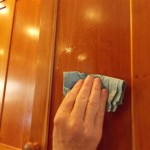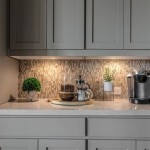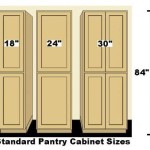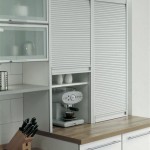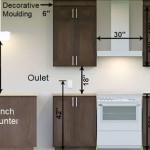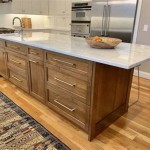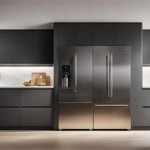Kitchen Cabinetry Cost
Kitchen cabinets are a significant investment in any home renovation or new construction project. Understanding the factors influencing cabinetry costs can help homeowners budget effectively and make informed decisions. This article explores the various elements that contribute to the final price tag of kitchen cabinets.
Cabinetry costs are typically categorized into three tiers: stock, semi-custom, and custom. Stock cabinets are pre-manufactured in standard sizes and styles, offering the most budget-friendly option. Semi-custom cabinets offer more flexibility in terms of sizing, finishes, and features, occupying a middle ground in terms of cost. Custom cabinets are built to exact specifications, allowing for complete control over design and materials, but come at the highest price point.
Within each cabinet category, material selection significantly impacts the overall expense. Common cabinet materials include solid wood, plywood, particleboard, medium-density fiberboard (MDF), and melamine. Solid wood cabinets are generally the most expensive, prized for their durability and aesthetic appeal. Plywood offers a balance of strength and affordability, while particleboard and MDF are more budget-conscious choices, often covered with a veneer or laminate. Melamine, a plastic laminate applied to a substrate, is a cost-effective and low-maintenance option, typically used in stock or ready-to-assemble (RTA) cabinets.
The type of wood used also plays a role in cost. Hardwoods like oak, maple, and cherry tend to be more expensive than softer woods like pine. Exotic woods, such as mahogany or zebrawood, command a premium price due to their rarity and unique grain patterns.
Cabinet construction methods further influence pricing. Frameless cabinets, also known as European-style cabinets, generally cost less than framed cabinets due to their simpler construction. Framed cabinets, the traditional American style, feature a face frame around the cabinet box, adding to material and labor costs.
The size and configuration of the kitchen directly affect the number of cabinets needed, impacting the overall budget. Larger kitchens or those with complex layouts will naturally require more cabinets, increasing the total cost. Likewise, the number of drawers, specialty storage solutions like pull-out shelves or spice racks, and decorative elements like molding or glass inserts all contribute to the final price.
Finish options significantly influence cabinet pricing. Painting cabinets typically costs more than staining due to the labor involved in achieving a smooth, even finish. Specialty finishes, such as glazing or distressing, also add to the expense. Hardware choices, from simple knobs and pulls to high-end designer hardware, can represent a surprising portion of the overall cabinetry budget.
Installation costs represent a substantial portion of the total kitchen cabinetry expense. Professional installation ensures proper fit and function, but adds to the project budget. Factors influencing installation costs include the complexity of the kitchen layout, the number of cabinets being installed, and the geographic location. Homeowners opting for DIY installation can save on labor costs but should possess the necessary skills and tools to ensure a successful outcome.
Geographic location plays a role in both material and labor costs. Areas with higher labor costs and limited access to certain materials may experience higher overall cabinetry prices. Shipping expenses can also add to the cost, particularly for custom or semi-custom cabinets ordered from distant manufacturers.
Obtaining multiple quotes from reputable cabinet suppliers and installers is crucial for comparing pricing and ensuring a competitive offer. Detailed specifications, including cabinet style, materials, finishes, and hardware, should be provided to each vendor to ensure accurate and comparable quotes. Careful consideration of budget, desired features, and long-term value will help homeowners make informed decisions when selecting kitchen cabinets.
Beyond the initial purchase and installation, considering the long-term costs associated with different cabinet materials and construction methods is important. Solid wood cabinets, while more expensive upfront, may offer greater longevity and require less frequent replacement compared to less durable materials. Evaluating the expected lifespan and maintenance requirements of different cabinet options can help homeowners make cost-effective decisions in the long run.
Understanding the interplay of these various factors – cabinet type, material selection, construction method, kitchen size and configuration, finish options, hardware choices, installation costs, and geographic location – will equip homeowners with the knowledge necessary to navigate the complexities of kitchen cabinetry pricing and make informed decisions that align with their budget and design vision.
Researching different manufacturers and suppliers, comparing their offerings, and carefully reviewing customer feedback can also contribute to a successful cabinet selection process. Visiting showrooms and examining cabinet samples firsthand can provide valuable insights into the quality, construction, and finish of different options.

Modular Kitchen Cost Per Sq Ft How Much Should You Budget

What Is The Average Kitchen Cabinet Cost

What Does An Average Kitchen Cost Superior Cabinets

How Much Do New Cabinets Cost Bkc Kitchen And Bath

Kitchen Interior Design Cost In Designcafe

Low Cost Modular Kitchen Best Designs And More

Modular Kitchen Cost Per Sq Ft How Much Should You Budget

Cost Of Kitchen Cabinets Estimate Cabinet S 2024 Remodeling Calculator

Modular Kitchen Per Sqft Design And Installation Tips

Modular Kitchen Cost Per Sq Ft How Much Should You Budget
Related Posts

